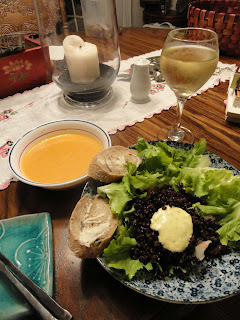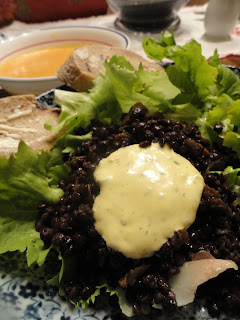I still cook!
Don't think that just because the heat of summer has set in I have abandoned my kitchen. It isn't as pleasant as it is in winter, and cozy is not a Virginia in June ideal, but one still has to eat... T being out of town earlier this week, I took the opportunity to cook a week's worth of grain-based meals. Add to this the fact that I am currently reading Julia Child's
My Life in France, and the urge to cook (and eat) some good old
cuisine bourgeoise simply overtook me. I'll say more about Julia Child, her book, her food, her city later. Suffice to say that I am reading up on France, Paris and french food and wine in anticipation of a trip I'll be making later this year. You see, August is the first anniversary of my 39th birthday and for this momentous occasion, T is sending me to France with a good friend of ours, he not being able to go along due to work.
Thus, to prepare my taste buds I am gearing up with French food cooking and eating, French wine drinking and France-related reading. I decided to start with what has to be my favorite French soup. No, not onion soup au gratin, but
Potage de Crécy, a creamy and clean carrot soup. It is amazing how easy this dish is, and how satisfying it can be, as long as your carrots are sweet and elementally carroty. Start by chopping a small onion (about 3/4 cup), then chop carrots until you have three cups. You don't need to chop perfectly, as this soup is puréed. Saute the onion in some butter in a soup pot, or large saucepan. Add the carrots, 2 quarts of stock (vegetable or chicken) 1 T tomato paste and 2 T uncooked white rice. Bring to boil and simmer until the carrots are tender.
Take it off the heat and let it cool for a bit so you don't scald yourself (I speak from experience). Blend the soup until creamy, either in a blender, food processor or an immersion hand blender. At this stage it looks rather like homemade baby food, but don't fret, it gets better.
Add whole milk, cream or half-and-half. Season with salt and pepper and that's it! I made mine this time with heavy cream that needed to be used up, but you can use something lighter if desired.
This soup is such a comfort to me, in all four seasons. It is the perfect weeknight meal, along with a salad and some homemade bread. My bread this week is made with Kalmata olives and the saltiness and tang of the olives is the perfect foil to the silky softness of the just-sweet-enough soup.
The other dish I made up, and although it didn't specifically come from a French cookbook, I could see it being eaten in a rural French household. It is black beluga lentils simmered in white wine and stock and served with an escarole salad and goat cheese. This is easy too. I chopped another onion, two smallish carrots and a clove of garlic. I sauteed this in olive oil then added two cups of lentils. To this I added a mix of white wine and chicken stock, about 32 oz in all.
I threw in some thyme and a little dill. I simmered it until the lentils were tender and the liquid absorbed.
I seasoned with salt and pepper and let it cool. While it cooled, I cleaned a head of escarole and mixed a quick lemon vinaigrette (olive oil, lemon juice, white wine vinegar, salt, pepper, sugar). I added some goat cheese (feta is good too) to the lentils and of course, more bread.
Of course, if you are being inspired by Julia Child, as I am this week, you can always whip up a quick batch of homemade herbed mayonnaise to go on top. This was really very easy. Actually, it was frightening how something so inherently unhealthy can be so easy to make.
I took one egg, cracked it into the blender with a little salt and a little mustard (she calls for mustard powder, but I seemed to be out so I used Dijon mustard (straight from Burgundy!) and blended for about a minute. Then I added a tablespoon of lemon juice and blended some more. Then I slowly drizzled olive oil into the blender as it whirred. Probably about 1/2 to 2/3 cup.
And that was it.
Due to the vividness of the yolk color in the Polyface eggs, this is a lot yellower than store bought mayonnaise. It is also tangier. In fact, perhaps I used too much mustard, but it is still great. Also, I don't know that I would go 100% olive oil the next time I made this as the olive flavor comes out very strong, which is not a bad thing, but on a turkey sandwich it may not be The Thing.
I added some chopped fresh herbs to it and let it sit for awhile in the fridge and whopped a dollop onto my lentils. Mmmm....
All of the above is great with a crisp, dry white wine. As I continue to educate myself on Bordeaux wines before I actually go there, I recently picked up a wonderful white at Whole Foods, a 2009 Chateau Magence from Graves. If you can get a hold of a bottle of this light and refreshing wine, do so and don't let go.

I am not a big fan of whites typically. I think Chardonnay tastes like grass, which can be a good taste, but not in a wine and not with my dinner. The other problem I have with many whites is that the perfumed floral aroma can be over the top. Nothing to me is more unpleasant than to open a bottle of white, sniff and instantly be taken back to first grade and the artificial smell of my Hello Kitty eraser. Preferring to think that someone headed towards their forth decade on this planet has developed at least a minimal sense of sophistication, I don't look for that kind of nostalgia in my wine. This is white however is perfect. Dry, not syrupy but with a lingering sweetness, and a nose that is fresh, spicy and true to its fruit. If all Bordeaux whites are like this, I am going to have a great time amongst the vines in September.
So there you have a week's worth of simple, French inspired, meatless meals. I leave you with a quote from
My Life in France, part of a rejection letter Julia Child received when she was trying to find a publisher for the book that would make her name a household word, the venerated
Mastering the Art of French Cooking.
You spoke of the revised project as a 'short simple book directed to the housewife chauffeur.' The present book could never be called this. It is a big, expensive cookbook of elaborate information and might prove formidable to the American housewife. She might easily clip one of these recipes out of a magazine but be frightened by the book as a whole.
Hmph.




















































